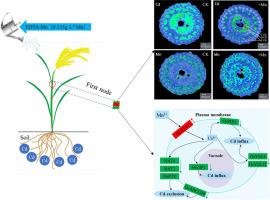微区分析和转录组分析揭示了锰抑制水稻第一节镉积累和向上转运的机制
IF 6.8
Q1 PLANT SCIENCES
引用次数: 0
摘要
锰(Mn)抑制水稻中镉(Cd)的积累,Mn和Cd共享多个转运蛋白,但Mn和Cd在水稻中的相互作用机制尚不清楚。本研究通过田间和盆栽试验证实,Mn降低了籽粒(Cdgrain)的Cd含量。叶面喷施EDTA-Mn时,Mn浓度为0.135 g L-1,对Cdgrain的抑制效果最好(66.7%)。第1节(N1)镉粒与镉粒呈极显著正相关,与其他部位相比下降幅度最大(0.19 mg kg-1)。LA-ICP-MS观察到Mn显著降低了N1中Cd和Zn的密度,且茎束中央Cd的降低幅度大于外周鞘束。SEM-EDS结果也证实了N1中Cd和Zn的比例随着Mn比例的增加而降低。因此,N1是Cd与Mn相互作用的关键部分。转录组数据支持Mn喷施上调了OsACA3的表达,下调了N1中金属转运基因的表达,可能通过下调OsYSL8、OsABCG39、OsPT8、NAT2、NAT6、OsYSL12、OsZIP1等基因抑制了Cd的向上转运。本研究确定了Mn的最佳实用形态和施用浓度,完善了喷Mn抑制Cdgrain的分子调控机制,为喷Mn在水稻安全生产中的应用提供了重要的研究依据。本文章由计算机程序翻译,如有差异,请以英文原文为准。

Micro-Area and Transcriptome Analysis revealed the mechanism of manganese inhibits the accumulation and upward transport of cadmium in the first node of rice
It was proved that manganese (Mn) inhibits the accumulation of cadmium (Cd) in rice, and Mn and Cd share multiple transporter proteins, but the interaction mechanism between Mn and Cd in rice is still unclear. This study confirmed that Mn decreased the Cd content of grain (Cdgrain) through field and pot experiments. Moreover, the foliar spraying of EDTA-Mn with the Mn level of 0.135 g L-1 obtained the best inhibitory effect (66.7%) on Cdgrain. Cdgrain was significantly positively correlated with Cd in the first node (N1) which showed the greatest decrease(0.19 mg kg-1) compared with that of the other parts after Mn spraying. It was observed by LA-ICP-MS that Mn significantly decreased the density both of Cd and Zn in N1, and the reduction of Cd in the central stem bundle was higher than that in the peripheral sheath bundle. The SEM-EDS results also verified that the proportion of Cd and Zn in N1 decreased with the increase of Mn proportion. Therefore, N1 is the key part of the interaction between Cd and Mn. Transcriptome data supported that the spraying of Mn upregulated the expression of OsACA3, downregulated the expressions of metal transporter genes in N1, which may inhibit the upward transport of Cd by downregulate genes such as OsYSL8, OsABCG39, OsPT8, NAT2, NAT6, OsYSL12, and OsZIP1. This study identified the optimal practical form and application concentration of Mn, and improved the molecular regulation mechanism of spraying Mn to inhibit Cdgrain, which provided an important research basis for the application of spraying Mn in rice safety production.
求助全文
通过发布文献求助,成功后即可免费获取论文全文。
去求助
来源期刊

Plant Stress
PLANT SCIENCES-
CiteScore
5.20
自引率
8.00%
发文量
76
审稿时长
63 days
期刊介绍:
The journal Plant Stress deals with plant (or other photoautotrophs, such as algae, cyanobacteria and lichens) responses to abiotic and biotic stress factors that can result in limited growth and productivity. Such responses can be analyzed and described at a physiological, biochemical and molecular level. Experimental approaches/technologies aiming to improve growth and productivity with a potential for downstream validation under stress conditions will also be considered. Both fundamental and applied research manuscripts are welcome, provided that clear mechanistic hypotheses are made and descriptive approaches are avoided. In addition, high-quality review articles will also be considered, provided they follow a critical approach and stimulate thought for future research avenues.
Plant Stress welcomes high-quality manuscripts related (but not limited) to interactions between plants and:
Lack of water (drought) and excess (flooding),
Salinity stress,
Elevated temperature and/or low temperature (chilling and freezing),
Hypoxia and/or anoxia,
Mineral nutrient excess and/or deficiency,
Heavy metals and/or metalloids,
Plant priming (chemical, biological, physiological, nanomaterial, biostimulant) approaches for improved stress protection,
Viral, phytoplasma, bacterial and fungal plant-pathogen interactions.
The journal welcomes basic and applied research articles, as well as review articles and short communications. All submitted manuscripts will be subject to a thorough peer-reviewing process.
 求助内容:
求助内容: 应助结果提醒方式:
应助结果提醒方式:


